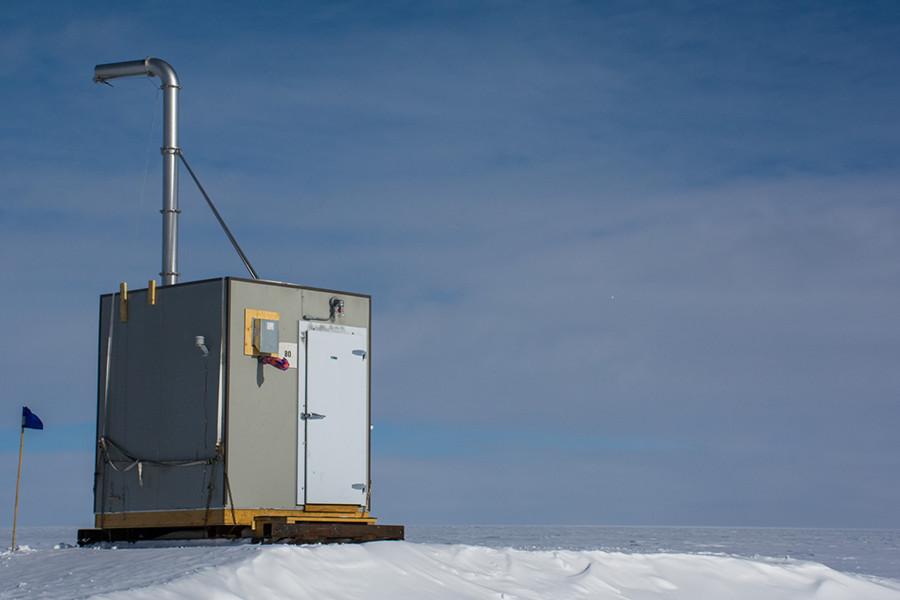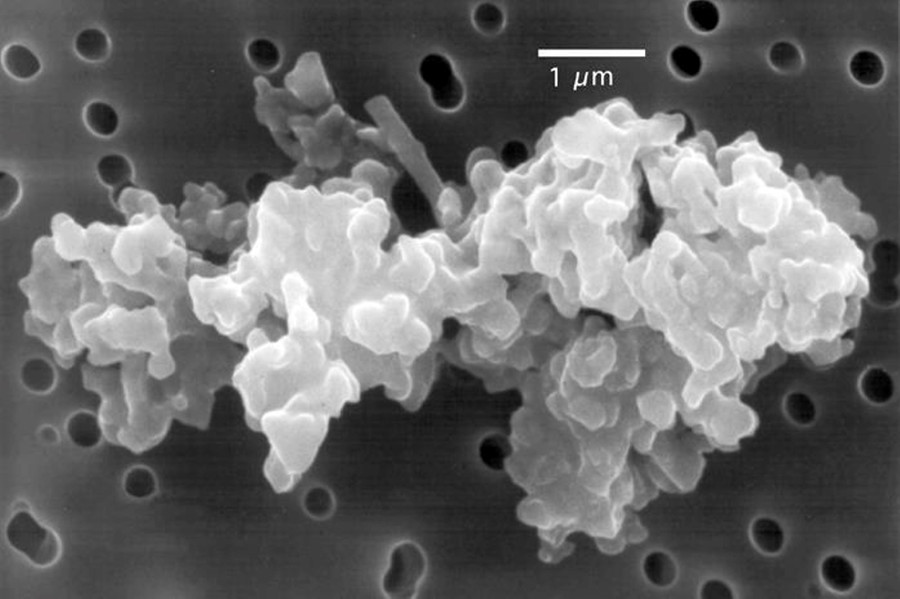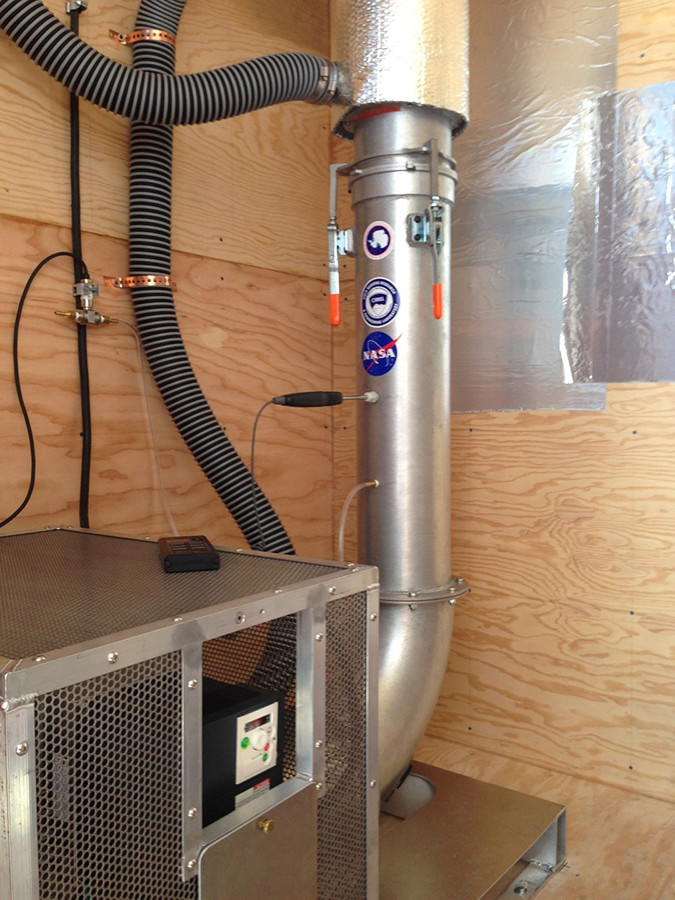
Photo Credit: Mike Lucibella
|
The Cosmic Dust Sucker sits on the edge of the South Pole’s clean air sector, pulling in air and filtering out micrometeoroids.
|
The Cosmic Dust Sucker
Pulling Space Dust Out of Thin Air
By Michael Lucibella, Antarctic Sun Editor
Posted January 4, 2017
At the South Pole, the ice is so thick that the only dust comes from outer space.

Photo Credit: Don Brownlee
Cosmic dust particles, like this one seen under an electron microscope, can be leftovers from before our solar system coalesced into planets, or particles from distant star systems.
The Earth is constantly showered with micrometeorites, every minute of every day. These interstellar particles are no bigger than a grain of sand, but are falling out of the sky everywhere. Collecting this cosmic dust, and separating it from terrestrial contamination, has led scientists to the most remote corner of the planet.
Much of the cosmic dust is leftover from a time billions of years ago, before the planets formed, when the solar system was nothing more than a giant cloud of swirling dust and gas. These grains offer scientists a peek at the primordial building blocks that coalesced into planets and moons of our solar system more than four billion years ago.
“This stuff probably made up our solar system, so it’s interesting to know about what kinds of materials got homogenized into what’s now our planet and Solar System,” said Susan Taylor, of the U.S. Army Cold Regions Research & Engineering Laboratory.
Taylor heads a team of researchers who recently built a sampler to pull these particles straight out of the air at the National Science Foundation’s Amundsen-Scott South Pole Station. Dubbed the “Cosmic Dust Sucker,” their project draws in air and filters the cosmic dust.
“It’s just going to be sucking 24 hours a day, 7 days a week,” said Taylor. “We have a blower that is basically a vacuum that is pulling air at five meters per second through aluminum pipe that extends six meters above the surface of the snow.”
Located at the edge of the already established clean air sector at the South Pole, the experiment is housed in a small building with a large bent intake tube sticking out of its roof. Resembling a giant silver juice box, the pipe on top points into the prevailing winds that sweep over the hundreds of miles of the barren polar plateau. The ever-present wind carries these particles over the pristine, dirt-free plateau, which is then pulled in by the suction of the dust sucker.
In addition, vehicle traffic is restricted upwind of the station, so the air reaching the experiment is the purest, least polluted air on the planet.

Photo Credit: Jim Lever
The Dust Sucker’s tangle of tubes belie its simplicity. Ducts connect the intake pipe on the top of the sucker’s structure to the fan drawing in air from the outside. The filter itself is located just below the silver heat exchanger at the top which melts ice crystals entering the device.
“We’re really trying to minimize contamination, that’s the name of the game here,” Taylor said. “If we can minimize contamination we don’t have to look at thousands and thousands of funny little grains to find these [cosmic] few.”
The clean air and lack of dirt for hundreds of miles makes the isolated South Pole station the ideal spot to test out this new technique.
“What you have is you have altitude, which is really good, you have really clean air, you’ve got very steady winds that are blowing from the clean air sector… and you have infrastructure,” Taylor said. “If we were to try to do this out in the middle of Antarctica somewhere, we would have to have some sort of a generator which then makes its own pollution.”
Mixed in with the embryonic dust grains of our early universe, are a few that originated from distant solar systems and supernovae many light years away; cosmic material that spent thousands or millions of years crossing the vast interstellar distances between the stars.
“We have the possibility of getting samples from other places that we will never be able to travel to,” Taylor said. “We have spectroscopic data of different stars and different molecular clouds, but these [dust grains] would actually be samples of those places.”
Researchers know that these dust grains are not from around here because the light that stars and dust clouds emit offer insight into what they’re made of. Embedded in their glow is a unique signature given off by the different elements and different isotopes of their constituent elements. Using a process called spectrometry, scientists can break apart this light and read the signatures of all the different fundamental components within these astronomical objects.
The isotopic signatures of some of the more unusual dust grains they’ve recovered bear more of a resemblance to distant stellar objects, than what’s in our own neighborhood.
“On the whole, everything in [our] solar system that we’ve been able to analyze so far has an isotopic composition in oxygen, and some of the other elements, that have a very narrow range,” Taylor said “These ‘pre-solar’ grains are way out there, they’re so different they’re not from our Solar System.”
The hope is that by running the cosmic dust sucker nonstop throughout the year, they’ll be able to collect orders of magnitude more cosmic dust particles that current methods.

Photo Credit: Mike Lucibella
The intake pipe for the dust sucker faces into the wind coming from the clean air sector. Before being drawn into the experiment, the wind blows over hundreds of miles of barren polar plateau, making for some of the purest air in the world.
“It’s a proof of concept,” Taylor said. “What we’re hoping is that if this really works out well, other people can build similar collectors for other promising locations.”
Scientists have long traveled to some of the most remote regions of the planet to collect extraterrestrial particles that fell to Earth.
“Collecting cosmic dust actually has a long and colorful history,” Taylor said. “The first ones were collected from the abyssal seabed by the Challenger expedition in the 1860s.”
That expedition was the first to send sediment collectors to the bottom of the deepest point in the ocean. Remarkably, the red clay deposits in the middle of the deep sea, seven miles below the surface, teemed with particles from outer space. Far away from any terrestrial dust contamination blowing off any continents, the benthic clay made any dust stick out.
Since then, new methods have been developed, but each has their drawbacks. NASA flies planes in the stratosphere with special panels coated in silicon oil for the dust to stick to. However this silicon oil can potentially contaminate the samples themselves, and the planes can only fly for limited amounts of time, restricting the amount of dust they can collect.
The French and Japanese Antarctic programs melt many cubic feet of snow and ice to collect the cosmic dust that’s fallen out of the sky and embedded in the snow. However the process of heating the snow to melt could affect the chemistry of the dust grains within.
Taylor’s technique should be the lowest impact way to collect this dust in its original form. The particles pulled in by the dust sucker dust accumulate on a 3-micron filter inside the blower, without the need for heating or chemical cleaning afterwards.
“They’re being collected much more gently,” she said.
Having interchangeable filters along with a constantly running blower should also allow the researchers to trace some particles directly back to their source.
“We should be able to get an idea of what things come down when,” Taylor said. “If there’s a big event, like if there’s a big meteor shower, we can change the filter to see if we can if we can get [samples] from that particular event.”
The dust sucker is now just starting its first runs.
“I ran a filter for half a day when we started it up just to check for contamination. The sample looked really clean,” Taylor said. “Then we ran another one for six days, and that one I haven’t opened here. That one I’m going to open in the clean room when I get back and I’m hoping that we’ll have particles. We’ll know soon.”








